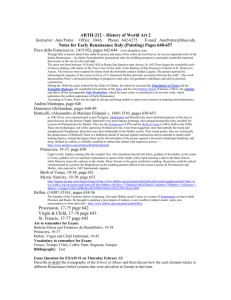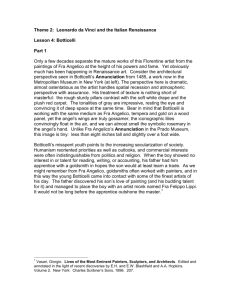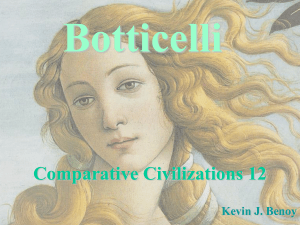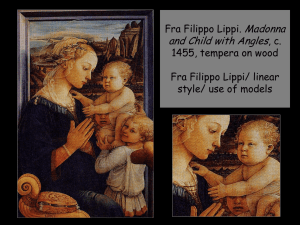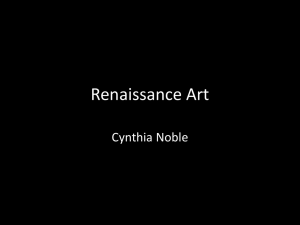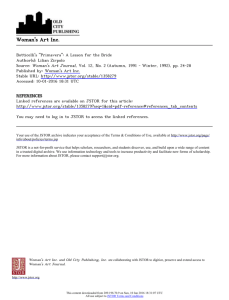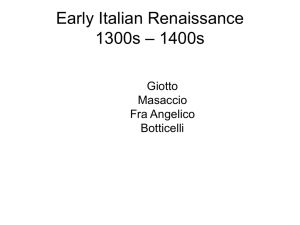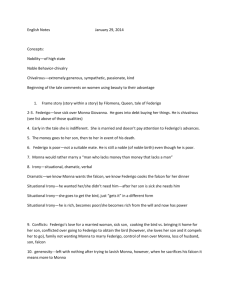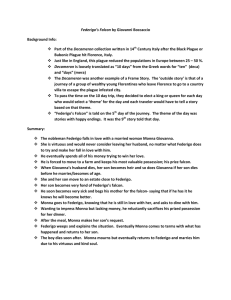Read Sample Selection
advertisement
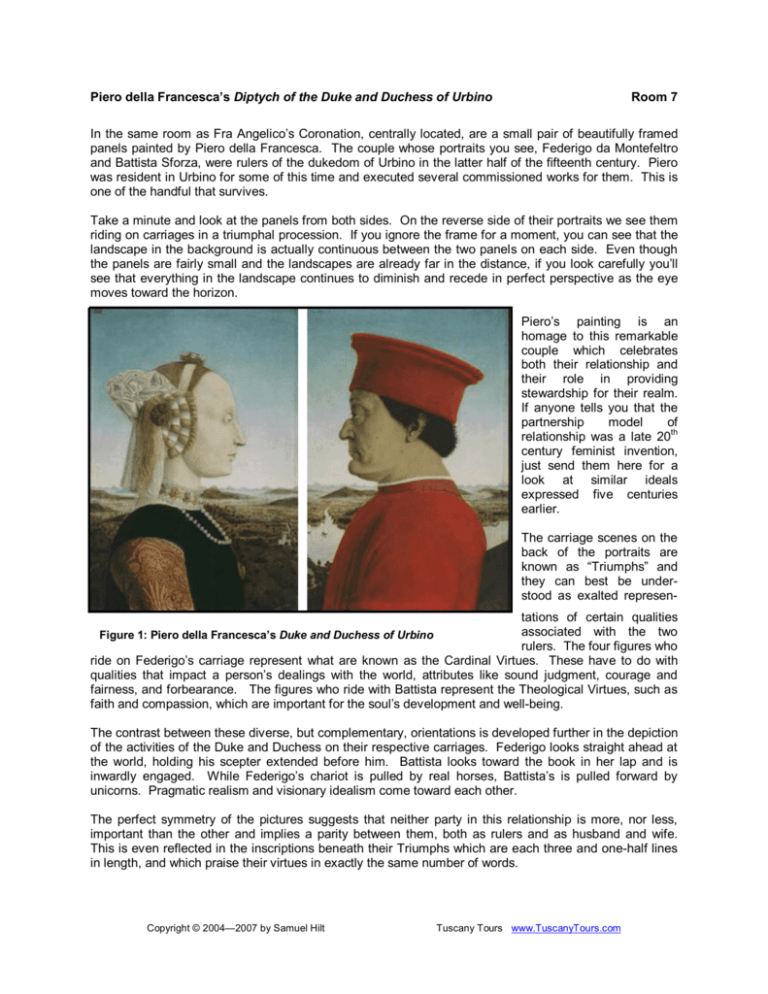
Piero della Francesca’s Diptych of the Duke and Duchess of Urbino Room 7 In the same room as Fra Angelico’s Coronation, centrally located, are a small pair of beautifully framed panels painted by Piero della Francesca. The couple whose portraits you see, Federigo da Montefeltro and Battista Sforza, were rulers of the dukedom of Urbino in the latter half of the fifteenth century. Piero was resident in Urbino for some of this time and executed several commissioned works for them. This is one of the handful that survives. Take a minute and look at the panels from both sides. On the reverse side of their portraits we see them riding on carriages in a triumphal procession. If you ignore the frame for a moment, you can see that the landscape in the background is actually continuous between the two panels on each side. Even though the panels are fairly small and the landscapes are already far in the distance, if you look carefully you’ll see that everything in the landscape continues to diminish and recede in perfect perspective as the eye moves toward the horizon. Piero’s painting is an homage to this remarkable couple which celebrates both their relationship and their role in providing stewardship for their realm. If anyone tells you that the partnership model of relationship was a late 20th century feminist invention, just send them here for a look at similar ideals expressed five centuries earlier. The carriage scenes on the back of the portraits are known as “Triumphs” and they can best be understood as exalted representations of certain qualities associated with the two Figure 1: Piero della Francesca’s Duke and Duchess of Urbino rulers. The four figures who ride on Federigo’s carriage represent what are known as the Cardinal Virtues. These have to do with qualities that impact a person’s dealings with the world, attributes like sound judgment, courage and fairness, and forbearance. The figures who ride with Battista represent the Theological Virtues, such as faith and compassion, which are important for the soul’s development and well-being. The contrast between these diverse, but complementary, orientations is developed further in the depiction of the activities of the Duke and Duchess on their respective carriages. Federigo looks straight ahead at the world, holding his scepter extended before him. Battista looks toward the book in her lap and is inwardly engaged. While Federigo’s chariot is pulled by real horses, Battista’s is pulled forward by unicorns. Pragmatic realism and visionary idealism come toward each other. The perfect symmetry of the pictures suggests that neither party in this relationship is more, nor less, important than the other and implies a parity between them, both as rulers and as husband and wife. This is even reflected in the inscriptions beneath their Triumphs which are each three and one-half lines in length, and which praise their virtues in exactly the same number of words. Copyright © 2004—2007 by Samuel Hilt Tuscany Tours www.TuscanyTours.com Federigo’s Triumphal Chariot Battista’s Triumphal Chariot Come back again to the portraits on the previous page and you’ll see how these same themes are subtly developed in the portraits themselves. These portraits are typically praised for their “realism”, but this really misses the point. Battista is actually shown in a highly idealized manner: her complexion is perfect and her skin is unnaturally pale; her hair is beautifully tressed and interlaced with intricately folded silk; her crown and neckline are ornamented with lustrous pearls and gems. Beside her, Federigo is shown with his broken nose, his hair growing over his ears, the crow’s foot in the corner of his eye, even the moles on his cheek. The polarity between them is as palpable as their profound unity. They stand erect, their heads just above the distant horizon. Just as the panels are evenly divided between earth and sky, so do they hold together heaven and earth. Before we leave them, there’s one more thing to do. Take a moment and imagine that they are looking at each other. Do you see how they look at each other, seeing and allowing themselves to be seen? For better and for worse, as if eternally exchanging vows at a marriage: the king, the queen, and the land. Copyright © 2004—2007 by Samuel Hilt Tuscany Tours www.TuscanyTours.com Botticelli’s Primavera Room 10 As you make your way from Filippo Lippi’s work into the adjacent rooms that house Botticelli’s masterpieces, it’s worth noting that Filippo was Botticelli’s teacher. And, after Filippo’s death, it was Botticelli who took over the artistic education of Filippo’s son, Filippino Lippi. Although they languish under greenish-tinted bulletproof glass, Botticelli’s Birth of Venus and his Primavera still retain much of their magic. These are mysterious, dream-like images that invite interpretation, and there is certainly no shortage of fascinating and conflicting readings. It’s fun to speculate about their meanings—and totally appropriate—but let’s begin with what we know that can provide some orientation. One of the first things worth noting about these two paintings is that they were among the first large-size paintings during the Renaissance to depict mythological subjects. Mythological themes were common on decorative platters and household furnishings, but, before Botticelli, painting on this scale was reserved for altarpieces with Christian themes. Simply by working on this scale Botticelli invites us to treat these images with a degree of seriousness not usually devoted to mythological topics. Another thing we know about these two paintings is that they were intended for the edification of the adolescent nephew of Lorenzo de’ Medici, ruler of Florence. We know something, even today, about teenage boys and pictures of beautiful naked women, so we can be fairly sure that he was not unhappy with this gift. But we also know that Lorenzo was the patron of the Florentine Platonic academy and that he and his cousin, Lorenzo di Pierfrancesco, probably had a more complex agenda in mind when they commissioned the work from Botticelli. Botticelli was an integral part of this circle of poets and scholars and artists who were deeply committed to recovering the esoteric wisdom of the ancient pagan world and integrating it with contemporary Christian belief. One member of the group, Marsilio Ficino, even wrote a book called Platonic Theology in which he tried to show that Plato’s mystical teachings about the soul were entirely compatible with Christian dogma. So, it’s in this context that we need to begin looking at the Primavera and the Birth of Venus. Figure 2: Botticelli’s Primavera Copyright © 2004—2007 by Samuel Hilt Tuscany Tours www.TuscanyTours.com Let’s start with the Primavera (which was completed a few years before its companion piece). As we explore, we’ll try to stay close to what we can actually observe without going too far afield into classical sources. First of all, if you step back and look at the movement within the image, you’ll notice that things seem to move from right to left. Most of the figures in the painting are turned toward or facing (our) left; some are leaning that way; blindfolded Cupid is aiming his arrow in that direction. So, the ways in which the figures are standing, looking and gesturing draws our attention across the canvas from right to left as we stand before it. Now, notice also how our focus moves up and down as we move right to left. The winged blue figure descends from the heavens and bends the branches of the trees as he crashes through them. You can see his blue wing in the upper right corner of the painting. (This is, incidentally, the only area of the upper foliage that is barren of fruit.) From him we pass down to the nymph he has grabbed, then, an upward diagonal carries our eye to the woman scattering flowers and on to the regal figure in the center of the painting. Her outstretched hand moves our eye down to the first of the dancing maidens, then up to the hand-bridge over the head of the middle dancer, down to the last and, finally, over to the young man who pulls our eyes upward as he pokes his wand into the clouds on the upper left. The dance that our eye performs as it moves across, and up and down, is a perfect mirror of the dance of the three maidens who raise and lower their joined hands as they circle. Isn’t this an exquisite way of inviting us to join the festivities? *** Now let’s look more closely at the figures in this dance as we make our way across from right to left. The movement begins with the aerial creature who has come down from the heavens. He’s blue—like the sky behind him, like our flesh in the cold of winter, like depression, like aching gonadal longing. His entrance on the scene seems to be abrupt, unexpected, somewhat frightening, at least for the nymph who leans away from him as if trying to flee. Yet, whatever it is that transpires between them bring forth a stream of flowers from her mouth. The figure to her left with the floral gown doesn’t share in her apparent distress, but simply prepares to scatter a handful of the flowers which she has gathered in the fold of her dress. The green-leafed vine with pink flowers that emerges from the first girl’s mouth merges with the flowers of the other girl’s dress and appears again in the garland that she wears in her hair. Also, if you look closely at the nymph’s hands, you’ll see that there are places where the flowers of the dress grow over her hands and other places where they are visible through them. All of which—in this age before morphing technologies—are ways of suggesting that the first girl necessarily precedes and is mysteriously transformed into the second. In fact when we look at the three female figures in an ascending series as they are pictured, we can notice a variety of progressive changes: The first figure is completely nude except for the filmy gown she wears. Her hair is loose and undressed. Her feet are bare. The second figure wears a flower dress and sports a floral necklace; her waist is girdled by a flowery vine (which, like the necklace, may be part of the dress). Her hair is loose but dressed with a garland. Her feet are bare. Copyright © 2004—2007 by Samuel Hilt Tuscany Tours www.TuscanyTours.com The third figure is dressed in tailored clothes. Her robe of red and blue shows detailed workmanship in the fabric patterns and the decorative bordering along the hemline. She wears gold jewelry. Her hair is carefully braided and she wears a jeweled headdress. Her feet are shod. The first figure tries to run away; the second walks purposefully; the third stands and presides. The sequence invites us to think in terms of three aspects of the feminine or three stages in the life of woman: the alluring nymph, naked and unfettered; the fruitful, flowering young mother; the mature woman: poised, self-possessed, sophisticated. Scholars who believe they have found the mythological sources of these figures identify them as Zephyr, the wind god; Chloris, the nymph whom he pursues; Flora, the goddess of springtime and flowers; and Venus, the goddess of love and beauty. But one of the things that’s marvelous about Botticelli’s image is that we don’t really need labels: the figures already show us who they are. In the ways that they move, dress and carry themselves, they embody the play of energies that reference to the classical myths merely confirms. As we move left, the dance continues. Over the head of Venus/Aphrodite, a blindfolded Cupid gets ready to shoot a fierytipped arrow at one of the dancers (familiar to most of us as “The Three Graces”). If you carefully follow the line of the arrow, you’ll see whom he’s aiming at. It’s the middle dancer, the one whose shoulder is bare, her buttons all undone. The other two are holding their bridged hands over her head like a canopy. She stares intently at the young man off to her left who is poking around in the clouds. We’re left to imagine, now that he’s caught her eye, what will happen once the arrow strikes. The young man on the far left is draped in an elegant fabric; his feet are shod and his sandals have wings. He carries a sword and wears a sort of helmet or crown. He holds a caduceus in his right hand, a wand around which two snakes intertwine. The caduceus is associated still today with medicine and healing, and formerly would have been recognized as well as a sort of magic wand. Our young man is using his tool for exploring the mysteries of the heavens where his gaze and his attention are fixed. We’re reminded of Aldous Huxley’s definition of a genius as someone who doesn’t think about sex all the time. There’s a perfect symmetry between the couples who frame the dance before us. We begin with an aerial creature who is pulled downward by hunger and desire while the nymph he grasps flourishes and flowers. And we end with a maiden about to fall in love with a young man of noble bearing whose thoughts are fixed on celestial things. If we think once again about the education of Lorenzo’s nephew, we might consider that there’s something here to grasp about how love hits us wildly from below, transforms us, and then carries us to the threshold of sublimity. The male entering Aphrodite’s realm dives in headlong but exits standing upright and marveling at the heavenly majesty of it all. The woman is startled and apprehensive at her initiation into the mysteries of the body, but she then moves gracefully through them and is ultimately lured beyond them. Part of the inexhaustible fascination of the image is the sense of a world where all is as it should be, where art, beauty, and love are in perfect harmony, where the dance of earthly desire is revealed in its correspondences to the cosmic cycle of renewal. In this pagan dream of the Renaissance, we stop to marvel at the sophisticated embrace of eros in all its differentiations from lust through graciousness. And it makes our own dominant conceptions of sex as an animal need or “instinctual drive”—a sin if you’re not married but a blessing if you are—seem almost barbarous by comparison. Copyright © 2004—2007 by Samuel Hilt Tuscany Tours www.TuscanyTours.com
